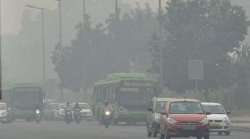Air quality in Delhi, surrounding areas turn 'severe'
Air quality in the national capital turned 'severe' on Tuesday with slow wind speed and low temperature allowing the accumulation of pollutants, according to weather department officials.

Air quality in the national capital turned 'severe' on Tuesday with slow wind speed and low temperature allowing the accumulation of pollutants, according to weather department officials. The air quality is likely to remain 'severe' on Wednesday too. No major improvement is predicted till December 26, Kuldeep Srivastava, the head of the India Meteorological Department's regional forecasting centre, said.
The city's 24-hour average air quality index (AQI) was 418, which falls in the severe category. It was 332 on Monday, 321 on Sunday and 290 on Saturday.
Air pollution in the neighbouring cities of Faridabad (407), Ghaziabad (468), Greater Noida (458) and Noida (450) also entered the "severe" zone.
An AQI between zero and 50 is considered "good", 51 and 100 "satisfactory", 101 and 200 "moderate", 201 and 300 "poor", 301 and 400 "very poor", and 401 and 500 "severe".
Srivastava attributed the dip in the air quality to slow wind speed, low temperature, and high humidity due to a Western Disturbance.
Low temperature makes the air heavier, trapping pollutants close to the ground, he said.
On Tuesday, the minimum temperature was 5.3 degrees Celsius and the maximum wind speed 8 kmph.
The central government's Air Quality Early Warning System for Delhi said the city's ventilation index, a product of mixing depth and average wind speed, was 2,000 m2/s on Tuesday and is likely to be 2,500 m2/s on Wednesday.
Mixing depth is the vertical height in which pollutants are suspended in the air. It reduces on cold days with calm wind speed.
A ventilation index lower than 6,000 sqm/second, with the average wind speed less than 10 kmph, is unfavourable for dispersal of pollutants.
Air quality in Noida, Ghaziabad, Greater Noida and Faridabad
The average air quality plunged to "severe" level in Ghaziabad, Noida, Greater Noida and Faridabad, while it was "very poor" in Gurgaon, according to a 24-hour data issued by a government agency on Tuesday.
Presence of pollutant PM 2.5 and PM 10 also remained high in the five immediate neighbours of Delhi, according to the air quality index (AQI) maintained by the Central Pollution Control Board (CPCB).
According to the index, an AQI between zero and 50 is considered 'good', 51 and 100 'satisfactory', 101 and 200 'moderate', 201 and 300 'poor', 301 and 400 'very poor', and 401 and 500 'severe'.
The average 24-hour AQI at 4 pm on Tuesday was 458 in Ghaziabad, 450 in Greater Noida, 437 in Noida, 407 in Faridabad and 377 in Gurgaon, according to CPCB's Sameer app.
The CPCB states that an AQI in the "very poor" category may cause respiratory illness on prolonged exposure while "severe" affects even healthy people and seriously impacts those with existing diseases.
The average AQI on Monday was 391 in Ghaziabad, 366 in Greater Noida, 363 in Noida, 289 in Faridabad and 271 in Gurgaon, while on Sunday it was 346 in both Ghaziabad and Greater Noida, 333 in Noida, 294 in Faridabad and 262 in Gurgaon.
The AQI for each city is based on the average value of all stations there. Noida, Faridabad, Ghaziabad have four stations each, while Gurgaon has three and Greater Noida two, according to the app.
(With PTI Inputs)